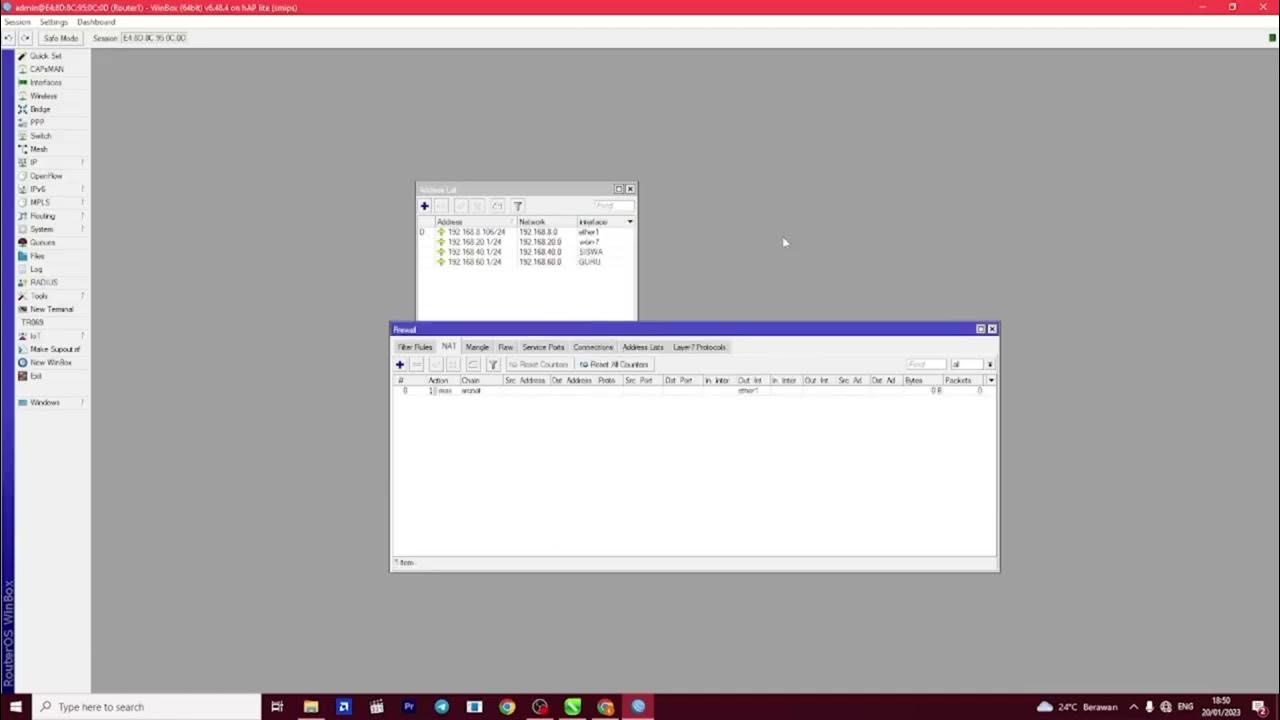PEMBAHASAN SOAL UKK TKJ 2025 Paket 2
Summary
TLDRThis video provides a comprehensive tutorial on configuring network devices for a UKK exam scenario. It covers setting up TCP/IP configurations, static and dynamic routing, as well as implementing a proxy server on a Mikrotik router. The guide includes steps for establishing LAN and wireless connections, configuring DHCP servers, setting bandwidth management, and enabling web proxy features. Additionally, it demonstrates testing network connections, blocking websites, and ensuring proper bandwidth limitations. Finally, it verifies that routing and internet access are functioning correctly, with a focus on both practical implementation and theoretical understanding.
Takeaways
- 😀 TCP/IP configuration is performed on two routers (Router A and Router B), with Router A connected to LAN and wireless, and Router B connected via LAN cable.
- 😀 Static IP addresses are used for LAN connections, while dynamic routing (OSPF) is configured for communication between the routers.
- 😀 A web proxy service is configured on Router B to manage internet traffic, and certain websites are blocked for security purposes.
- 😀 Router A uses DHCP client settings to receive an IP address, while Router B does not require a DHCP server but has a proxy feature enabled.
- 😀 Bandwidth management is applied, limiting download and upload speeds for both wired and wireless connections.
- 😀 The configuration includes setting up the OSPF routing protocol to ensure dynamic routing between the routers.
- 😀 Web access is tested to ensure that blocked websites are properly restricted on the network through the proxy.
- 😀 Speed tests are conducted to verify the bandwidth limitations on both the wired (640 kbps) and wireless (320 kbps) connections.
- 😀 Static IP addresses are manually assigned to clients for proper network setup and testing.
- 😀 Troubleshooting is done by checking the routing information on both routers, ensuring that both can successfully route traffic via OSPF.
- 😀 The video ends by confirming that all configurations, including proxy, dynamic routing, and bandwidth management, have been successfully implemented and tested.
Q & A
What is the purpose of the static routing configuration in this setup?
-The static routing configuration ensures that clients connected to the router can access the internet through predefined paths. Static routing is used to define fixed routes between networks, particularly for internet access.
How does dynamic routing work between Router A and Router B?
-Dynamic routing between Router A and Router B uses the OSPF (Open Shortest Path First) protocol. This allows the routers to automatically exchange routing information and adapt to network changes without manual configuration.
What is the role of the proxy feature in Router B?
-The proxy feature in Router B allows for managing web traffic, including filtering and blocking access to specific websites. It also handles caching, which improves network efficiency by storing frequently accessed web pages locally.
Why is NAT (Network Address Translation) enabled on both routers?
-NAT is enabled to allow multiple devices within a local network to share a single public IP address when accessing external networks, like the internet. It also helps with hiding internal IP addresses for security reasons.
What is the purpose of the bandwidth management configuration?
-Bandwidth management ensures that network resources are allocated efficiently. By limiting the bandwidth for specific interfaces (like the wireless and wired connections), the network can maintain optimal performance and prevent congestion.
Why were specific websites blocked using the proxy feature on Router B?
-Certain websites were blocked to enforce network usage policies or for security reasons. By configuring the proxy on Router B, specific websites can be denied access based on their domain names, preventing users from accessing them.
What are the DNS server settings used in this configuration?
-The primary DNS server used in the configuration is Google's DNS (8.8.8.8), and the secondary DNS is 253.33. This allows the network to resolve domain names to IP addresses effectively.
How does the OSPF routing protocol help in this network setup?
-OSPF dynamically exchanges routing information between Router A and Router B, ensuring that both routers can route traffic efficiently between their respective networks. It allows for automatic adjustment to changes in the network topology.
What is the significance of the IP address configurations on both routers?
-The IP address configurations on both routers define the networks they manage. Router A has a static IP setup for the wireless LAN, while Router B is connected through a wired interface. These addresses help in routing traffic and ensuring devices are properly connected.
How was the speed test used to verify bandwidth limitations?
-The speed test was used to verify that the bandwidth limits configured on both routers were correctly enforced. For example, the wired connection was limited to 640 kbps, and the wireless connection was limited to 320 kbps. The test confirmed these limits were effectively applied.
Outlines

هذا القسم متوفر فقط للمشتركين. يرجى الترقية للوصول إلى هذه الميزة.
قم بالترقية الآنMindmap

هذا القسم متوفر فقط للمشتركين. يرجى الترقية للوصول إلى هذه الميزة.
قم بالترقية الآنKeywords

هذا القسم متوفر فقط للمشتركين. يرجى الترقية للوصول إلى هذه الميزة.
قم بالترقية الآنHighlights

هذا القسم متوفر فقط للمشتركين. يرجى الترقية للوصول إلى هذه الميزة.
قم بالترقية الآنTranscripts

هذا القسم متوفر فقط للمشتركين. يرجى الترقية للوصول إلى هذه الميزة.
قم بالترقية الآنتصفح المزيد من مقاطع الفيديو ذات الصلة

PEMBAHASAN UKK TKJ PAKET 2 TAHUN 2023

2.9.1 Packet Tracer - Basic Switch and End Device Configuration

SSH Configuration on Cisco Routers and Switches using Cisco Packet Tracer

Simulasi VoIP Server softswitch pbx - Cisco Packet Tracer

Setting Router Mikrotik RB750 sampai Konek ke Internet (Untuk Pemula)

Membuat Topologi Jaringan 1 Gedung 3 Lantai Menggunakan Cisco Paket Tracer
5.0 / 5 (0 votes)
